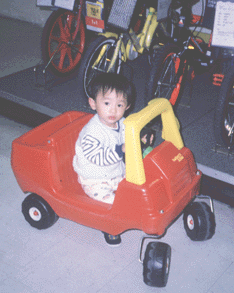Toy storiesThe past generation’s viewBy Teeny Chiu A 58-year-old accountant, Mr. Cheung Chi Ho, said, “When I was a child, my parents, like many others in society, did not buy toys readily. “Most families had many children but low salaries. The burden of a family was quite heavy. Toys were luxuries for children.” With economic growth, many families became wealthier, which allowed their children to possess more toys.
Photo by Teeny ChiuA 39-year-old housewife, Ms Fung Wai Ping said, “Since I have only two children, it is easier to satisfy their wants. “I have bought many toys and video games for my sons. When I was their age, I had only a few toys.” Ms Fung said she did not want her children to play in the streets as she did in the past. So she buys more toys as compensation. Mr. Cheung takes a similar view. He said, “Society was well-ordered in the past. Parents did not supervise their children so strictly and let them play outdoors. “Besides, the harmonious at-mosphere in the multi-storeyed residential buildings we lived in enabled children to play with their neighbours.” Confined by limited resources, children made use of their unlimited creativity to entertain themselves. Said Mr. Cheung: “Handmade toys prevailed in my childhood. My friends and I liked to make our toys using simple materials like paper, wood, and iron. Products like paper frogs, paper guns, iron boxes, wooden aeroplanes and ships were our inventions. They brought us great satisfaction and happiness. “We also created games, like a dragonfly hunting competition. Children who caught the largest amount of dragonflies were the winners. After the hunt, we held a funeral for the insects.” Ms Ida Lai, a 19-year-old professional accountancy student at The Chinese University of Hong Kong, was also a “game inventor”. Said she: “We usually played a special chess game in which the chessmen would be replaced by anything that was available. We set the rules ourselves. We played happily because we could manipulate everything.” For the past decade, games like “What Time Is It, Mr. Fox?”, “Red and Green Traffic Lights” and rubber-band “string jumping” have been very popular among children. Since many high-quality toys are available, children can get them easily. Ms Lai said that children might be lazy and not try to create their toys or games. According to Dr. Chan Wai, a lecturer in the Department of Psychology at The Chinese University of Hong Kong, children’s creativity in the past might have been higher. Said he: “Though there may be some toys designed to inspire children’s thinking, their effectiveness is not so obvious. “They are different from the old ones, like ‘Marble Chess’, which required children to decide what to do next. Other forms of chess also serve the same function. They were popular among children in the past.” “However, since children now have more choices for recreation, they usually do not select chess. There are fewer chances to train their minds. Besides, the rules of the toys also limit their creativity,” he added. Children now play with toys rather than with people. Children’s personal communication skills may be weakened. Said Dr. Chan: “Since most games at that time required many children to take part, their communication skills would have been enhanced. “However, most toys and games nowadays are designed for only one player. This may exploit the chance of interpersonal communication and children may not know how to express themselves.” Recalling her childhood with few toys, Ms Lai insisted that playing with companions was a happier time than when playing alone. “I made many my friends through the games and the happy memories still remain. “Though sometimes we might compete for the
toys, we would learn to share. We also learned to treasure our scarce toys. However,
children can now get toys easily. They may waste what they possess.” [Culture & Recreation Section Menu] |
